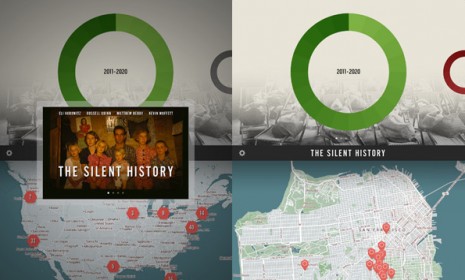The Silent History: The strange new e-book that makes you travel to read it
An ambitious new e-book pushes the boundaries of interactive fiction by requiring readers to visit specific locations to unlock new parts of its story

If you want the full experience of The Silent History — a new e-book available on the iPhone and iPad — you'd better get ready to do some traveling. The Silent History is "part medical case study, part mystery novel, and part-real-life scavenger hunt," says Sarah Hotchkiss at KQED, and the e-book aims to personalize its narrative for each reader. (Watch a trailer for The Silent History below.) The Silent History is divided into two parts: Testimonials and field reports. The testimonials, which are divided into six volumes of 20 chapters each, are automatically unlocked as the story unfolds each day. But the field reports require an unprecedented level of interaction: They can only be read by traveling to specific locations, and readers are encouraged to write and contribute their own localized installments. How does The Silent History work — and is it the future of fiction? Here, a brief guide:
What is The Silent History about?
The story takes place between 2011 and 2043, chronicling a future in which many children — dubbed "silents" — are born without the ability to speak, though they also seem to possess strange powers that aren't fully understood. The testimonials and the field reports are independent fragments of the larger story, and The Silent History jumps around in space and time. The overall goal is to emulate the arc of a dramatic TV show, says Rachel Deahl at Publisher's Weekly, by telling a story that "draws viewers in with stand-alone episodes week to week as it builds to a longer storyline unfolding over the course of a full season."
The Week
Escape your echo chamber. Get the facts behind the news, plus analysis from multiple perspectives.

Sign up for The Week's Free Newsletters
From our morning news briefing to a weekly Good News Newsletter, get the best of The Week delivered directly to your inbox.
From our morning news briefing to a weekly Good News Newsletter, get the best of The Week delivered directly to your inbox.
Okay... but how does it work?
New testimonials are released once per weekday, no matter where you are. Field reports, on the other hand, will become available "only when your device's GPS matches the coordinates of the location," says The Silent History's website. Once a reader has reached one of these special locations, they'll be able to read the field report, which will be "deeply entwined with the particularities of their specific environments — the stains on the sidewalk, the view between the branches, a strangely ornate banister, etc — so that the text and the actual setting support and enhance each other."
What are readers saying about the field reports?
They're spooky — and powerful. "I opened a field report just a few blocks away from my house late at night," says Hotchkiss. "It was a simple story — a father describing walks with his silent son — that ended with the man writing his son's name in wet concrete." As I read the story, I looked down, and "there it was, just to my right, a name in the sidewalk I'd often passed but never noticed." Readers of field reports are also encouraged to become writers of field reports. "We are relying on new reporters," the website says, "to help expand our archive, especially in underrepresented neighborhoods or cities."
A free daily email with the biggest news stories of the day – and the best features from TheWeek.com
Can I read the book without going to these places?
Yes. "The Testimonials function as an entirely self-contained, fully-realized narrative, roughly the length of a 500-page book. The Field Reports are designed for readers who would like to explore the phenomenon in more depth or breadth. We certainly do not expect that any single reader will be able to visit all the reports."
Who came up with this?
The Silent History is a collaboration between Eli Horowitz, the former managing editor of McSweeney's, and writers like Kevin Moffett and Matthew Derby, as well as "a team of contributors on five continents." The book has also earned the support of celebrities, including Ira Glass and Miranda July, who narrate the book trailer.
Is it worth reading?
"I'm hooked," says Hotchkiss. The Silent History is "inspired," agrees Rose Tully at the San Francisco Chronicle, who had her own surreal experience with a field report at an intersection in San Francisco. And judging from The Silent History's Twitter feed, many other readers are finding themselves addicted: "I guess I will stand alone on 23rd Street at midnight reading on my phone," tweeted one early reader.
-
 Could smaller cars bring down vehicle prices?
Could smaller cars bring down vehicle prices?Today’s Big Question Trump seems to think so, but experts aren’t so sure
-
 2025’s most notable new albums
2025’s most notable new albumsThe Week Recommends These were some of the finest releases of the past year
-
 Trump aims to take down ‘global mothership’ of climate science
Trump aims to take down ‘global mothership’ of climate scienceIN THE SPOTLIGHT By moving to dismantle Colorado’s National Center for Atmospheric Research, the White House says it is targeting ‘climate alarmism’